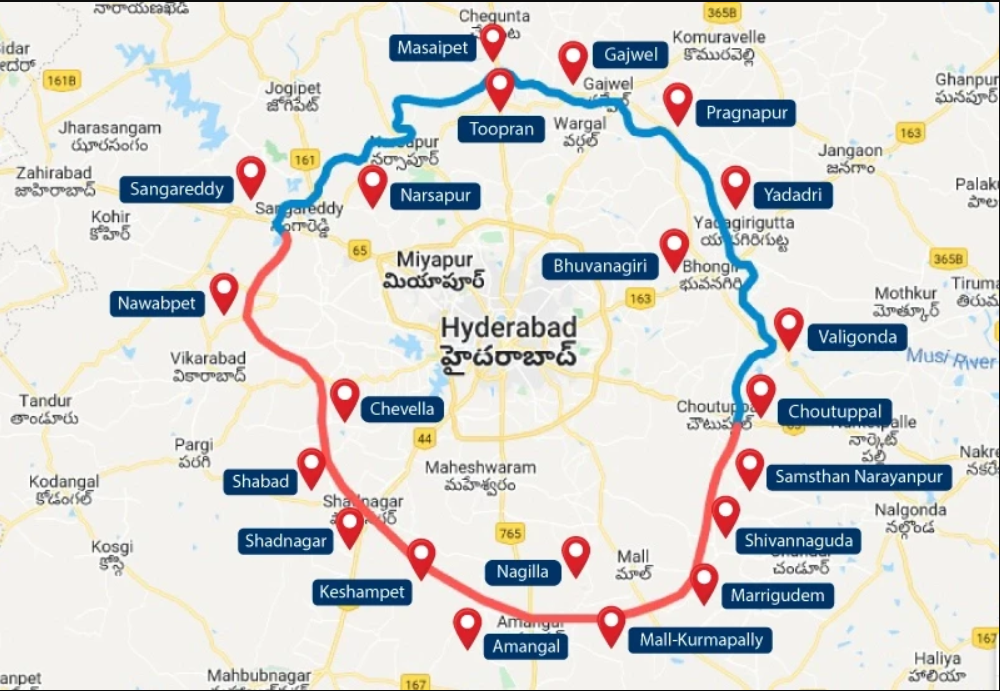
2025 Guide to Real Estate in Ibrahimpatnam

Exploring Real Estate in Ibrahimpatnam: A Rising Market for Smart Investors
In the sprawling real estate landscape of Hyderabad, certain localities emerge not merely as suburbs, but as strategic frontiers poised for transformative growth. Ibrahimpatnam, a region in the Rangareddy district, stands at such a precipice. It is the focal point where massive state-led infrastructure projects, powerful global economic drivers, and meticulously planned urbanization are converging to create what many analysts consider an unprecedented investment opportunity. This is not just another story of suburban expansion; it is the narrative of a calculated metamorphosis from a peripheral area into a vital economic and residential hub.
The investment thesis for Ibrahimpatnam is exceptionally robust, anchored by a rare combination of three foundational pillars. First is a trifecta of connectivity infrastructure: the existing Outer Ring Road (ORR), the game-changing upcoming Regional Ring Road (RRR), and a new high-speed expressway designed to link them. Second is a dual economic engine, fueled by the colossal Hyderabad Pharma City and the established Adibatla Aerospace and IT corridor, promising a diverse and sustained demand for housing. Third, and perhaps most crucially, is a government-backed master plan that provides a clear developmental roadmap, significantly de-risking long-term investment.
This guide offers a comprehensive journey into the Ibrahimpatnam real estate market. It will dissect the macro-level growth catalysts, delve into the micro-details of property prices and trends, spotlight key projects and developers, assess the social infrastructure, and provide a practical checklist for making a smart investment. It aims to equip prospective investors and homebuyers with the deep, analytical knowledge required to navigate this dynamic market and capitalize on its immense potential.
A critical point of clarification is essential before proceeding. This report focuses exclusively on Ibrahimpatnam, located in the Rangareddy District of Hyderabad, Telangana. Online property listings frequently conflate this area with another Ibrahimpatnam near Vijayawada, Andhra Pradesh. These are two distinct real estate markets, and all analysis herein pertains solely to the Hyderabad locality, which is rapidly becoming one of the city’s most talked-about investment destinations.
Why is Ibrahimpatnam Booming? Key Growth Drivers

The meteoric rise of Ibrahimpatnam as a real estate hotspot is not a product of speculation but the result of deliberate, large-scale planning and economic development. Understanding these fundamental drivers is the first step for any serious investor. The area’s future is being shaped by three powerful, interlocking forces: a revolutionary upgrade in connectivity, the establishment of massive employment-generating economic zones, and a formal government blueprint for structured growth.
New Roads and Highways: ORR, RRR, and a New Expressway
Superior connectivity is the lifeblood of any thriving real estate market, and Ibrahimpatnam is set to benefit from an unparalleled network of three major expressways. This is not merely an improvement of existing roads but the creation of a new, multi-layered transportation grid that will redefine the region’s economic geography.
The Outer Ring Road (ORR): The Foundational Artery
The Nehru Outer Ring Road is the 158-kilometer, 8-lane expressway that already encircles Hyderabad and serves as the foundational layer of Ibrahimpatnam’s connectivity. It provides seamless access to the city’s most important economic zones, including the IT hubs of Gachibowli and Hitec City, the Financial District, and the Rajiv Gandhi International Airport (RGIA). This existing infrastructure ensures that Ibrahimpatnam, while offering a serene environment, is never disconnected from the core of the city’s commercial life.
The Regional Ring Road (RRR): The Economic Game-Changer

The upcoming Regional Ring Road (RRR) is the most ambitious infrastructure project set to impact the region. This 340-kilometer, 4-lane access-controlled expressway is being developed under the Bharatmala Pariyojana initiative with an estimated cost ranging from ₹17,000 crore to ₹21,480 crore. The RRR is designed to orbit Hyderabad approximately 30-50 km beyond the ORR, functioning as a massive bypass for inter-state highway traffic.
Crucially, Ibrahimpatnam is a key node located on the Southern Corridor of the RRR. This 182-km southern arc will connect major towns like Choutuppal, Kandukur, Amangal, and Chevella, integrating several national highways, including NH-65 (Pune-Machilipatnam) and NH-163 (Hyderabad-Warangal), the latter of which passes directly through the Ibrahimpatnam area. By diverting heavy logistics and commercial traffic away from the city’s core, the RRR will transform the entire Ibrahimpatnam-Choutuppal belt into a prime corridor for warehousing, manufacturing, and trade, fundamentally altering its economic landscape.
The “Ratan Tata Road” Expressway: The High-Speed Connector
Complementing the two ring roads is a brand-new, 41-kilometer, 6-lane greenfield expressway, unofficially christened “Ratan Tata Road”. This project is specifically designed to provide a high-speed, access-controlled link between the ORR at Raviryal (near the Tata Interchange) and the proposed RRR at Amangal, cutting directly through the Ibrahimpatnam and Maheshwaram mandals.
Developed by the Hyderabad Metropolitan Development Authority (HMDA) with a projected cost exceeding ₹4,000 crore, this expressway is a monumental project in its own right. The government is acquiring over 1,000 acres of land for this 41-km road, a testament to its scale and strategic importance, especially when compared to the 6,000 acres acquired for the entire 158-km ORR.
The interplay between these three major road networks forms a deliberately engineered logistical triangle. The ORR provides the vital link to Hyderabad’s internal economic engines like the IT corridors and the airport. The RRR creates an external bypass for interstate commerce, connecting the region to the wider national economy. Finally, the new “Ratan Tata Road” acts as a high-speed shuttle between these two rings, specifically designed to service the massive industrial zones like Pharma City and the proposed Future City. This configuration is poised to attract not just residential homebuyers but also a significant wave of logistics companies, warehouses, and ancillary industries. This transforms the investment proposition from one of simple land appreciation to a multi-faceted economic development play, creating a far more diverse and resilient economic base than that of a typical residential suburb.
The Adibatla-Mangalpalle Hub: Aerospace and IT Powerhouse
While Pharma City represents the future, Ibrahimpatnam also benefits from its proximity to an already established economic hub. The Adibatla and Mangalpalle areas are home to major high-tech employers, including the TATA Aerospace SEZ, Tata Advanced Systems, TCS Adibatla, and Cognizant. The proximity is immediate; for instance, a hotel in Bongloor, a locality adjacent to Ibrahimpatnam, is just 1.5 km from the TCS Adibatla campus. This corridor represents a significant base of high-skilled, white-collar professionals in the IT and aerospace sectors, creating consistent demand for mid-to-premium housing.
This economic duality provides a powerful risk mitigation factor for real estate investors. Markets that are overly reliant on a single industry can be vulnerable to sector-specific downturns. Ibrahimpatnam, however, is not just a “pharma city suburb” or an “IT suburb”; it is uniquely positioned to serve both. Pharma City is expected to generate massive demand for a wide spectrum of housing, particularly in the affordable and mid-segments, to accommodate its vast workforce. Simultaneously, the Adibatla hub fuels demand for premium properties like villas and high-end apartments from its well-compensated professionals. This economic diversification creates a more stable, resilient, and multi-layered real estate market, allowing investors to build a varied portfolio that caters to different rental segments and risk profiles.
Government Plans: The Hyderabad Master Plan 2031
A crucial factor that elevates Ibrahimpatnam above purely speculative investment zones is its formal inclusion in the government’s long-term vision for the region. The area is officially designated as a “critical growth corridor” in Hyderabad’s comprehensive Master Plan 2031.
This designation is more than just a label. It means that the development of Ibrahimpatnam is not left to chance but will follow a structured plan. The Master Plan encourages mixed-use development, which ensures a balanced and sustainable community with a designated mix of residential, commercial, recreational, and green spaces. This approach helps prevent the kind of haphazard and congested construction that has plagued other rapidly growing areas, promising a higher quality of life for future residents.
For an investor, the Master Plan acts as a powerful de-risking tool. The risk of investing in peripheral land often includes uncertainty about future zoning, a lack of planned amenities, and the potential for chaotic, unplanned growth. However, Ibrahimpatnam’s inclusion in the Master Plan 2031 provides a clear and official roadmap for its development. It gives investors the assurance that essential infrastructure such as roads, water supply, and electricity will be planned and implemented by government bodies like the HMDA. This official sanction transforms a potentially speculative land purchase into a strategic investment that is aligned with a long-term, government-backed vision, thereby boosting investor confidence and underpinning future property values.

